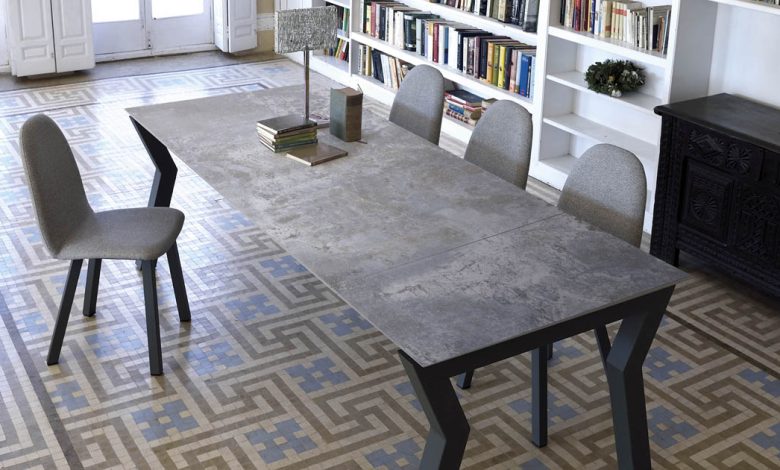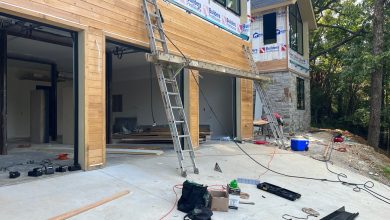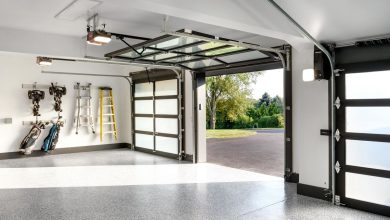Trend: Dekton invites itself into your decoration

The Dekton has been a great success for several years. Sometimes mistakenly assimilated to ceramic, this material is distinguished by its uniqueness. Always on the lookout for new materials to design aesthetic and practical creations, designers see in it a revolutionary material. How to explain such a success? A short presentation of this new fashionable material is in order!
WHAT IS DEKTON?
Dekton is a material invented and patented by the Spanish company Cosentino, also recognized for manufacturing high quality quartz “Silestone”. Dekton is a 100% mineral material that was not made by nature but by man. It consists of a mixture of glass, porcelain and quartz. It is designed using the latest technological innovations, in particular TSP technology (Particle Sintering Technology). To put it simply, this innovative technique uses a 25,000 ton press and several hundred meter ovens to reproduce in 4 hours the changes that a natural stone could have undergone exposed for thousands of years to high temperatures and pressures. The molecules of these materials, compressed and heated to very high temperatures, will then merge. This is called ultra-compaction of matter. This process offers a revolutionary material with very low porosity and an absence of micro-defects responsible for tensions that can weaken the plate. The composition of Dekton and its manufacturing process therefore make it a very resistant material.
WHAT ARE THE BENEFITS OF DEKTON?
Dekton is a well-known material that offers multiple advantages. Although it is not an indestructible material and should be taken care of, this material is more resistant than most other materials on the market. The proof with these few examples:
- Stain resistance: with this robust material, even stains such as ink, wine or even rust can be easily removed.
- Resistance to heat and thermal shock: pots, pans and other hot dishes can be placed directly on your Dekton tray without damaging it. The manufacturer nevertheless recommends avoiding contact with temperatures above 300°. When confronted with extreme cold, the Dekton is also not afraid of thermal shocks.
- Scratch resistance: Dekton is a material that is very resistant to scratches on metal utensils. It is nevertheless preferable to use a cutting board especially for shiny finishes. Also note that it is not recommended to use ceramic knives directly on the Dekton.
- Wear resistance: Dekton is said to be even more resistant to abrasion than granite. It is also frequently used as a floor covering and paving. You will therefore be able to enjoy a tray like new for the entire life of the product.
- UV resistance: Due to its ultra-low porosity, Dekton is very resistant to ultraviolet rays and the colors do not fade. Your Dekton tray will therefore keep all its shine even outdoors!
WHAT ARE THE USES OF DEKTON?
Dekton is a versatile material used in many ways. Here are its uses:
- The furniture and in particular the tables:
Many designers use this material in the design of high-end furniture and in particular tables. Practical, especially for placing hot dishes on it or for cutting food, the Dekton table also knows how to be aesthetic. We love it in all current interior decorations.
- Interior and exterior kitchen worktops:
Before integrating furniture, Dekton was initially used extensively in the design of kitchen worktops indoors and outdoors. Considered a premium material, Kitchen Dekton is easy to install and has a clean surface that is pleasant to the touch and easy to clean. A daily pleasure for all cooking lovers.
- Bathroom countertops:
Dekton is the flagship material of the modern and chic bathroom. Using the high performance and remarkable aesthetics of Dekton, designers are reinventing this space where hygiene and well-being take precedence. Through worktops or wall panels, Dekton for the bathroom will make this room an elegant and easy-going corner.
- Floors, paving and stairs:
Dekton is widely used in floors, paving and even stairs. Why this success? Quite simply thanks to its high resistance to wear and its elaborate aesthetics. With Dekton on the floor, there is no doubt that you will be envious and that it will keep its shine over the years!
- Building facades:
Modern architecture uses Dekton as an aesthetic and insulating material on many buildings. Used on ventilated, glued or curtain wall facades, this material will play with its style to enhance your building.
DEKTON A TAILOR-MADE MATERIAL
The Dekton has the advantage of being able to adapt to the use you want to make of it. How ? Thanks to its custom design. The Cosentino company manufactures Dekton sheets that meet the needs of many customers. Interior decorators, architects, kitchen and bathroom installers as well as designers take advantage of this flexibility to offer high quality custom creations.
WHAT COLORS ARE AVAILABLE?
Dekton is a material that relies on natural colors. A wide range of colors is available and is enriched each year. From white to black via grey, we love the uniqueness of colors. For even more character, we also love certain colors with a natural, organic or even oxidized look… for a singular and elegant result. When choosing, opt for a matte or glossy finish to punctuate the style of your shade! Among our favourites, the shiny veined shades reminiscent of polished marble and all the splendor of this material. You will see for yourself by looking at our Dekton tables, the styles are unlimited. The little extra: the good resistance of this material to UV which offers impermeability of colors even when it is confronted with direct sunlight.
WHAT IS THE PRICE ?
The Dekton is a wise choice if you are looking for practicality and quality without sacrificing aesthetics. Its price is higher than ceramic and other materials, however with this high-end material, there is no doubt that you will not be disappointed and that you will keep your table, your floor, your kitchen or your bathroom for a very long time. For example, count a higher price between 20 and 50% between a ceramic and Dekton table. This difference can of course fluctuate depending on the brand. If your budget allows it, this material is essential. Go for models at Homary.
HOW TO MAINTAIN DEKTON?
How do I clean Dekton? The answer is very simple since it is easy to maintain on a daily basis. The almost zero porosity of the surface makes it highly resistant to stains caused during a meal. All you need is a soft cloth moistened with a little warm water and dishwashing liquid or neutral soap. Another alternative is Q-Action applied to a microfiber cloth. These methods will remove most stains.
WHAT ARE THE POSSIBLE ALTERNATIVES TO DEKTON?
The Dekton is a great success but its price may logically put some people off. For those looking for a practical material to furnish their kitchen, here are some interesting alternatives:
Stainless steel: stainless steel is a resolutely practical metal material. We love its shine and its many advantages, including its resistance to corrosion and heat, its ease of maintenance and its hygienic properties. However, we regret its lack of decorative possibilities compared to Dekton.
Granite: Granite is a mineral material just like Dekton. Like the latter, it does not fear stains or scratches. You can cut directly on it without fear of damaging it. This material can be a good alternative to Dekton even if its resistance is lower.
Ceramic: ceramic is undoubtedly the material that most closely resembles Dekton from an aesthetic point of view. It also has good scratch and heat resistance. However, the commonalities end there. The low porosity and ultra-compaction of Dekton ensure superior quality to ceramic and better resistance to heat and scratches. Ceramic remains an interesting alternative to Dekton, read this article if you hesitate between choosing Dekton or ceramic.
Resin: resin is also a material that is easy to maintain, however do not plan to cut on it or place a hot dish on it at the risk of having to change tables quickly.
Wood: wood is not necessarily the most suitable material from a practical point of view. However, some manufacturers apply finishes to facilitate its daily maintenance. We obviously think of varnish or oil which prevents the infiltration of liquid into the wood. We will opt for this material only if you prefer the vegetal aesthetic to the mineral one because its practicality has no equal with Dekton and the other materials mentioned above.




